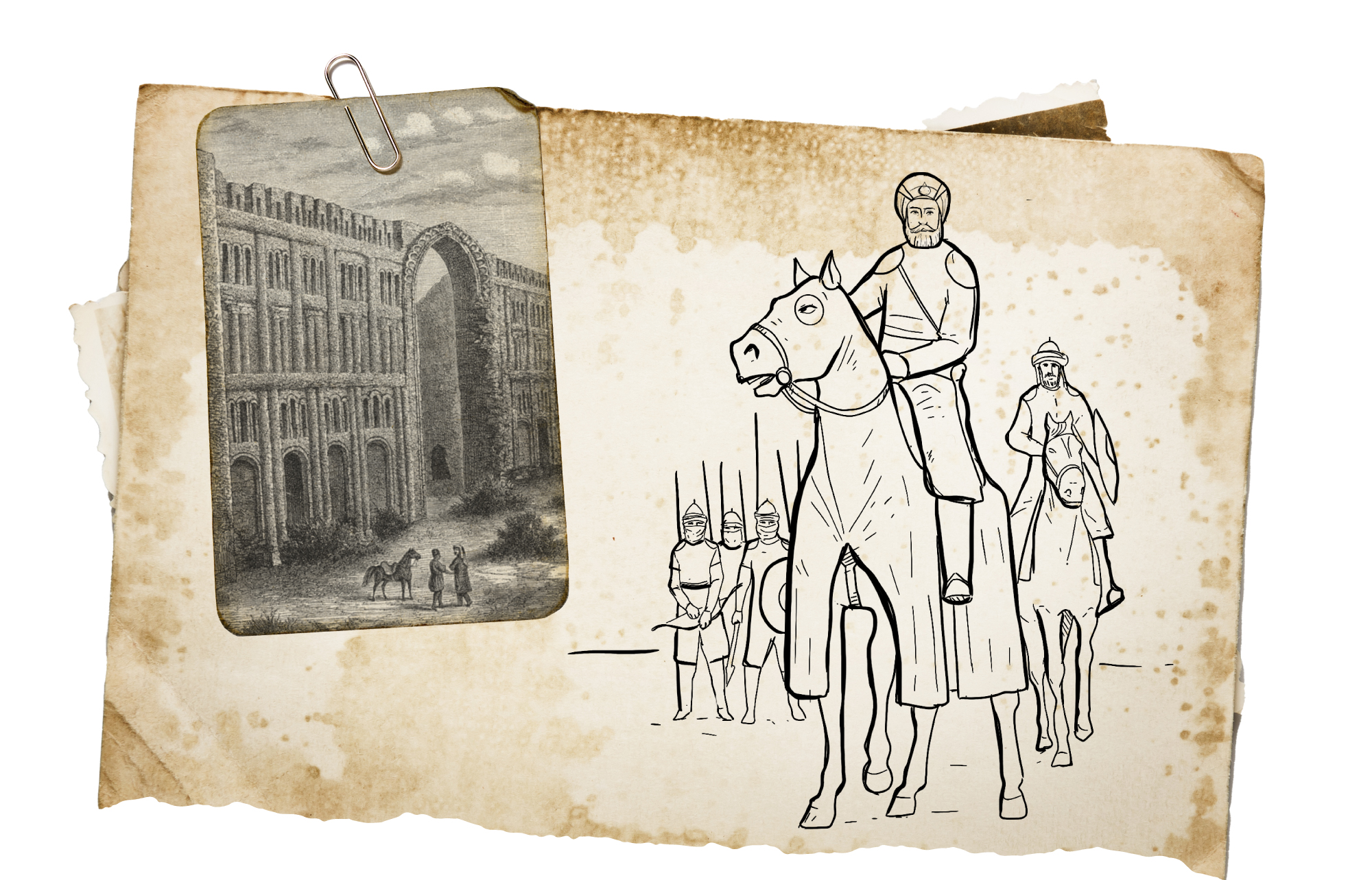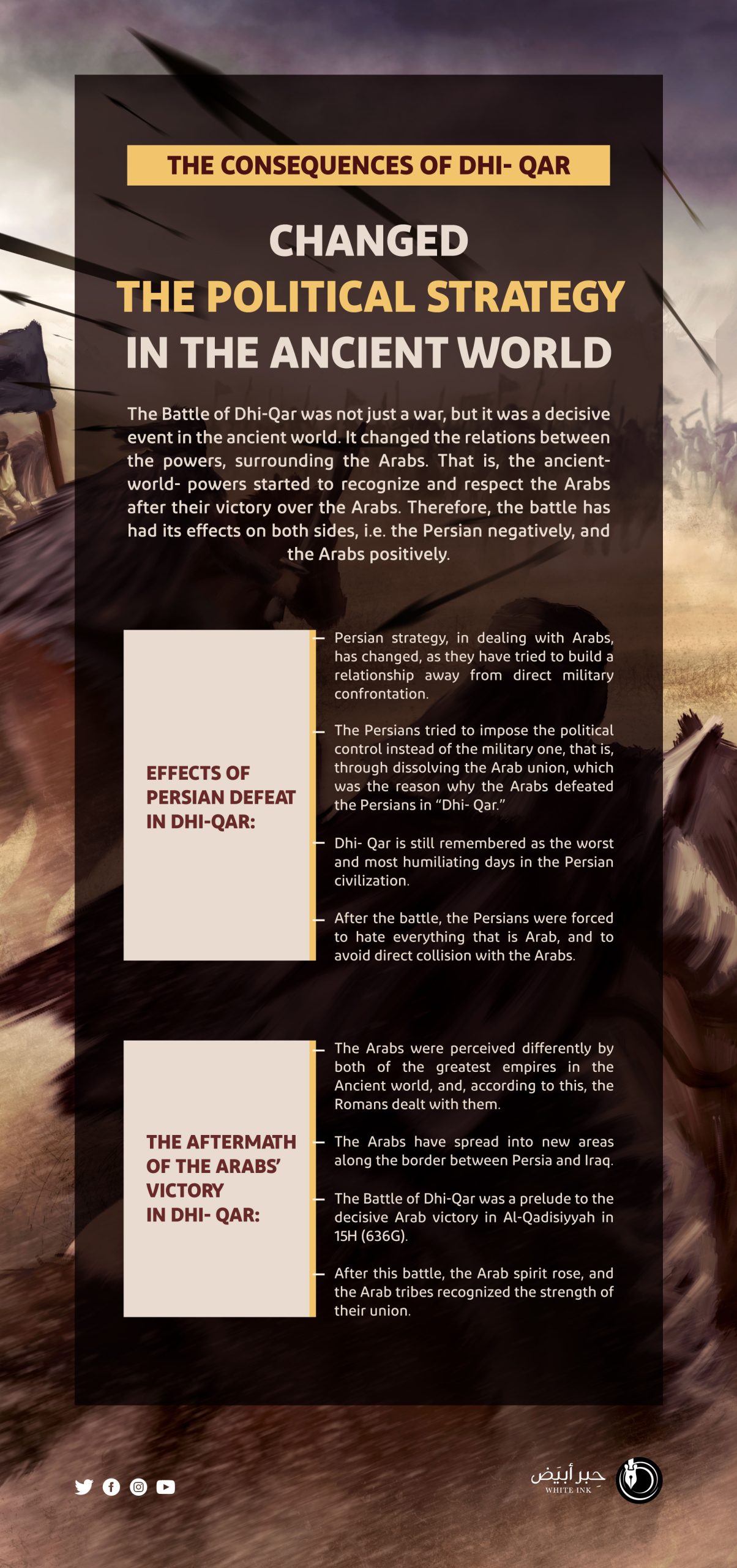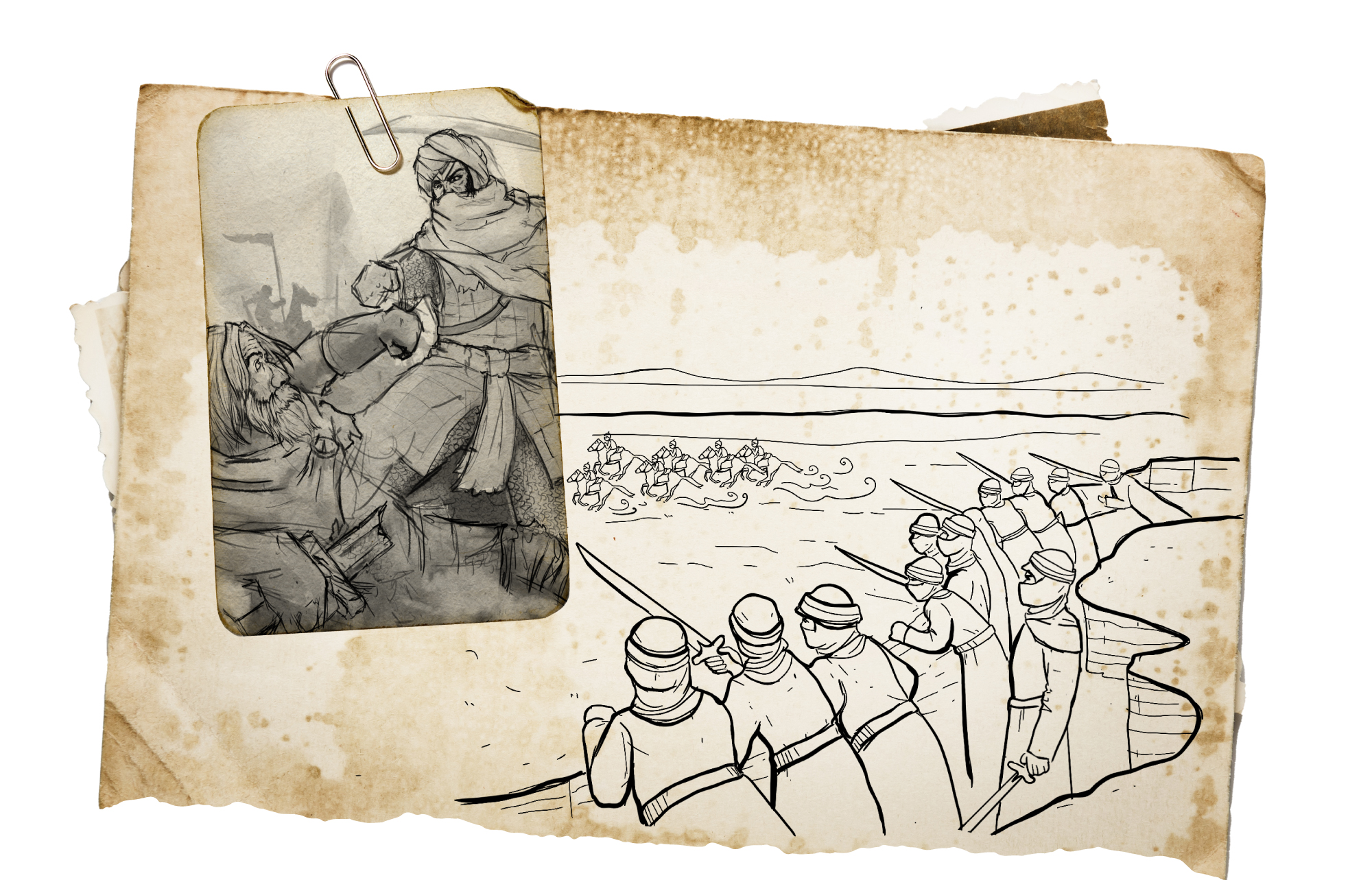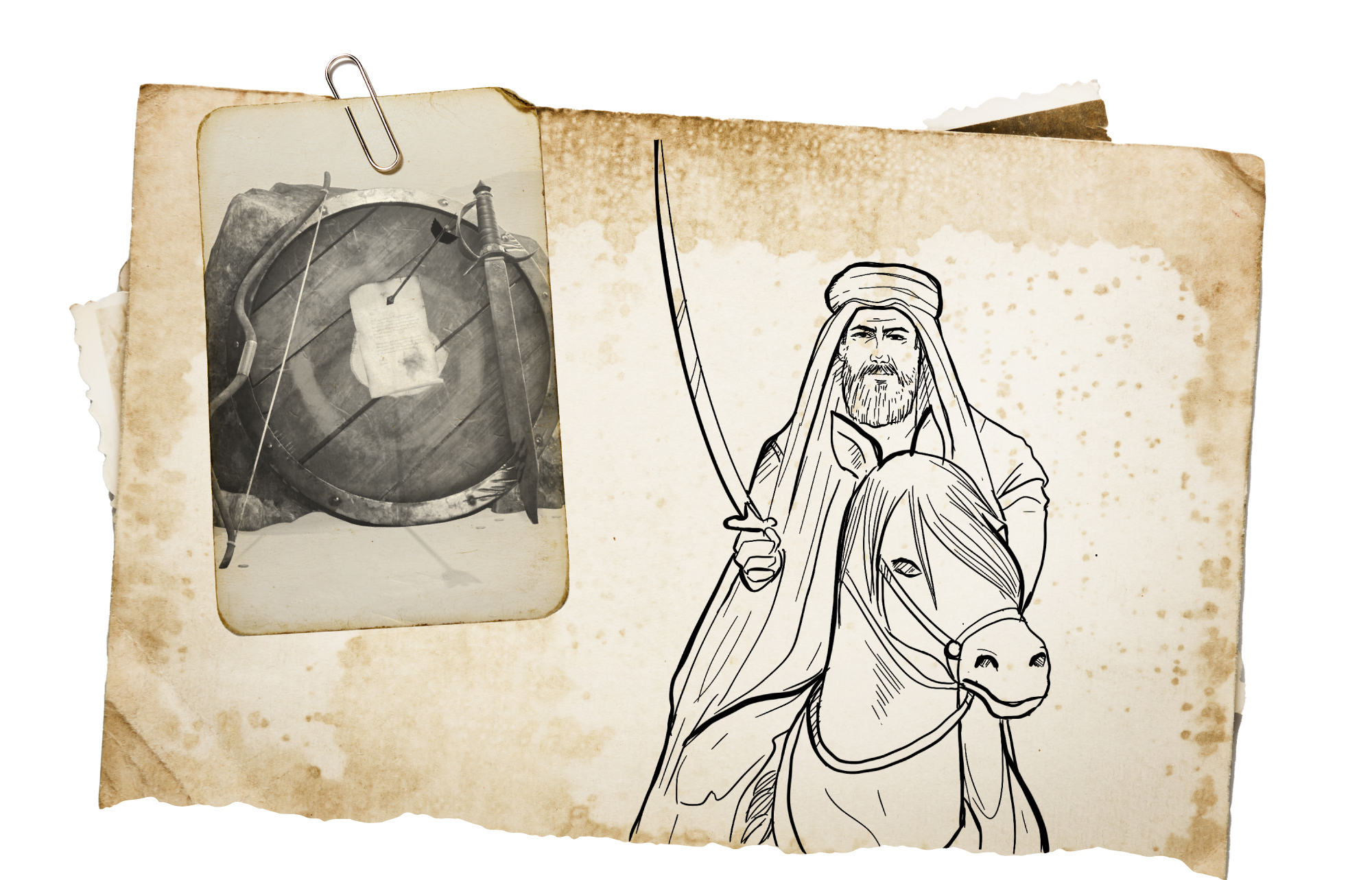
After he had created a crisis with the king of Al-Hira
Khosrau's failure to disperse the Arabs forced him to fight them
The Arabs still give the battle of Dhi Qar a special importance in their pre-Islamic history because it embodies an important moment in their days and embodies their unity before Islam. It is interesting that this battle is no less important in Persian history, and that is why the famous Iranian historian Hassan Pernia states that: “Although the battle of Al-Qadisiyyah was considered the first battle of the Arabs against Iran at that time, but if we take into account the results of the battle, we consider the battle of Dhi Qar to be their first battle against the Iranians”.
Due to the importance of Dhi Qar in history, we will try to capture the historical circumstances that led to this important event. Some researchers believe that there are direct and indirect reasons behind the clash between the Arabs and the Persians in Dhi Qar. They attribute the direct reason to the dispute that broke out between Khosrau and Al-Nu’man Ibn Al-Mundhir, as a result of the latter’s refusal to marry his daughter to Khosrau. Therefore, Khosrau summoned Al-Nu’man to his court, betrayed him and killed him. Khosrau knew that Al-Nu’man had entrusted his wives and money to Hani Ibn Masoud, one of the Arab leaders from Bakr bin Wael tribe. Therefore, Khosrau sent his messengers to Hani, threatening him, saying: “Al-Nu’man was my representative on Al-Hira, and he entrusted his money and his family to you, so send them to me. Do not make me send to you and to your people my soldiers who will kill the fighters and enslave the offspring”.
Hani Ibn Masoud, the man of magnanimity and Arab dignity, refused to betray his covenant to Al-Nu’man Ibn Al-Mundhir, and then Khosrau became angry with him, and the preludes of war began, and matters escalated to the point of confrontation.
Iraqi Khaled Al-Douri believes that this dispute may be the direct reason of the battle of Dhi Qar, but there are indirect reasons behind this that may be more important than the direct reason. The issue began with the policy of Al-Nu’man Ibn Al-Mundhir and his orientation towards the leadership of the Arab tribes and confronting the direct interference of the Persians in the affairs of the Kingdom of Al-Hira. Al-Nu’man turned into one of the important Arab figures against the Persians and he sought to unite the Arab tribes, so the clash between the Arabs and the Persians was inevitable. Al-Douri affirms the Arab poets’ support for Al-Nu’man Ibn Al-Mundhir, to the extent that Al-Nabigha Al-Dhubyani said about Al-Nu’man’s status:

On the other hand, Khosrau adopted a racist policy towards the Arabs, and it is mentioned about him that he said in the satire of the Arabs: “I did not see in the Arabs any good quality with regard to religion, worldly affairs, strength and firmness”. In addition to that, Khosrau applied the policy of divide and rule, as he sought the assistance of some Arabs against other Arabs. Therefore, he offered the rule of Al-Hira to one of them, saying to him: “Can you confront the Arabs on my behalf?”.
Some believe that Khosrau’s desire was not only to seize the women and money of Al-Nu’man that he left with Hani Ibn Masoud, but his greatest concern was to seize the weapons that Al-Nu’man left with Hani, as Al-Nu’man sent him hundreds of shields and bows before his death. It seems that this power began to worry the Persians, and their need became urgent to disarm the Arabs in order to keep them in a state of permanent weakness so that they could be easily controlled.
Therefore, Khosrau mobilized his armies to send them to the Arabian Peninsula in order to subdue the Arab tribes that refused to be subordinate to the Persians. The Iranian historian Hassan Pernia estimates the number of the army at about forty thousand men from the Persians and the Arabs cooperating with them. This army also accompanied a number of elephants in order to demolish the fortresses of the Arabs and terrorize them.
On the other hand, Hani Ibn Masoud provoked the Arab fervor against the Persians, as the tribes of Bakr Ibn Wael began attacking the lands of Iraq in a message addressed to Khosrau explaining the Arabs’ strength and their challenge to the Persian hegemony.
There were also numerous correspondences between Bakr tribes scattered throughout the Arabian Peninsula. The delegations came from Banu Bakr in Bahrain and Al-Yamamah, as well as the request of the prisoners of Banu Tamim at Banu Shayban to fight with them. The Arabs united and agreed to fight the armies of Khosrau at Dhi Qar, which became an immortal battle in the Arab memory and an important topic in the divans of Arab poetry.
Dhi Qar is still an important topic in the memory of Arabic poetry and its divans.



- Hassan Pernia, The Ancient History of Iran from the Beginning to the End of the Sassanid Era, translated by: Muhammad Nour Abd Al-Moneim, and Al-Sibai Muhammad Al-Sibai (Cairo: National Center for Translation, 2013).
- Khaled Al-Douri, The Arab Resistance to the Sassanid Influence in Al-Hira from 226AD to the Battle of Dhi Qar, Unpublished Master’s Thesis, College of Education, Tikrit University (2003).
- Abd Al-Wahhab Azzam, The Links between Arabs and Persians and Their literature in Pre-Islamic Times and Islam (Cairo: Hindawi Foundation, 2012).
- Homa Katouzian, The Persians: Iran in the Ancient, Medieval and Modern Times, translated by: Ahmed Hassan Al-Ma’ini (Beirut: Dar Jadawel, 2014).
- Jawad Ali, The Detailed History of the Arabs Before Islam, 4th Edition (Beirut: Dar Al-Saqi, 2001).


The Battle of Dhi Qar
Arab lessons in the “art” of military strategy
The purpose of studying the history of major battles is not to re-present what was written in the history books or to embellish them with usual phrases and words, but the goal is to extrapolate the events, understand the motives and extract lessons. Perhaps going back to the writings of Carl von Clausewitz or Henri de Jomini states that the development of strategic theories came as a result of analyzing dozens of battles and wars, and then deducing what was called “the art of war”.
The analysis of the Battle of Dhi Qar is an introduction to a set of conclusions that have been neglected by most of those who dealt with this Arab-Persian confrontation. It is the failure that Arab researchers are asked about, especially those who claim security and strategic analysis. Perhaps reviewing a group of strategic schools (Liddell Hart) confirms that the Arabs resorted to applying a set of war tactics that would not be rooted for centuries after that (Center of power theory, deflection theory, the theory of preferring defensive war over offensive war…).
Before detailing the battle from a strategic point of view, we will re-present its most prominent stations, according to the frequency of historical narratives, and then it will be analyzed according to the current concepts of “the art of war”. Here, the narratives of the battle of Dhi Qar agree on the two sides standing opposite each other and the emergence of a Persian fighter who challenged the Arabs to a duel. It did not take long until an Arab knight appeared to him, stabbing and killing him. The Persian commander became angry and went out himself calling for a duel. Al-Hawfzan, an Arab knight, confronted him and killed him.
The beginnings of the battle refer to two strategic mistakes that the Persians made. The first is related to the failure to benefit from the great numerical superiority that would have favored the Persians if the confrontation was direct and classic. As for the second mistake, it is related to the fall of the Persian army’s center of power, represented by the leaders, which constituted a severe blow to the morale of the enemy, who would fight without the head of the army.
Resorting to individual confrontations is usually in the interest of the lesser army, and this mistake was subsequently made by the infidels of Quraish in the face of Muslims in the famous Battle of Badr, which is the actual birth of the Islamic state. With regard to the battles that we read about, any army that was able to win in individual confrontations was not defeated in the battle, as was the custom of wars in the region.
Avoiding direct confrontation and the fall of the heads of the Persian army are from the strategic mistakes that Khosrau's army made in Dhi Qar.

The defeat of the Persians in individual confrontations had adverse effects on the unity of their army. This is what encouraged the Arabs and frustrated the Persians, to the extent that some Arabs who were loyal to the Persians longed for their Arab people, so they resolved to join them in the battle.
Strategic studies in wars and military confrontations, intentionally or unintentionally, excluded the confrontations in which the Arabs were one of the parties from their analyzes. If one of the most famous strategic theorists, the British Liddell Hart, had pointed out the importance of attacking from behind, then the Arabs in the Battle of Dhi Qar were the first to adopt this military tactic. In this regard, Hanzala had ordered some of his cavalry, led by Yazeed Ibn Hammar, to maneuver behind the Persians when the cavalry began attacking the Persians from behind. This military tactic associated with attacking from behind was devised by Liddell Hart in his book “Strategy and Its History in the World”, where he says: “The army is like a man who cannot defend effectively against a blow that comes from behind without turning around to use his weapons against this attacker and the process of “turning” makes the army lose its balance and puts it in an anxious position for some time and thus the brain is more affected by every danger coming from behind”.
The Arabs proved unparalleled cunning when they resorted to the tactic of turning around and attacking from behind, and these are the tactics that all those who have discussed wars and confrontation have dealt with for centuries. Here, Liddell Hart adds: “The movement around the enemy’s side or towards the rear of the army aims to avoid all resistance during the implementation of the movement and after it ends, and this movement takes the least resistance way”.
The battle of Dhi Qar cannot be limited to the strategic lessons that can be drawn from this historical confrontation (how a small army can defeat a large army, the enemy’s centers of power, the attack on the rear, and the cutting of the supply lines…). Rather, it can be considered a decisive turning point in the history of Arab-Persian confrontations. This is because the Arabs were confident of their ability to subdue the Persian enemy and they were convinced that the war which the righteous are forced to wage ends with their victory and the defeat of the people of arrogance and falsehood. Since Dhi Qar, the Persians had been in decline until Umar Ibn Al-Khattab subjugated their entire empire and then overthrew the Sassanid throne.


- Hassan Al-Jaf, Political History of Iran (Beirut: Arab Encyclopedia House, 2008).
- Elsayed Abdel Aziz Salem, History of the Arabs in the Pre-Islamic Era (Beirut: Dar Al-Nahda Al-Arabiya for Printing and Publishing).
- Raif Khoury, With the Arabs in History and Legend (Cairo: Hindawy Foundation, 2019).
- Liddell Hart, Strategy and its History in the World, 4th Edition (Beirut: Dar Al-Tali`ah for printing, 2000).
- Muhammad al-Tabari, History of the Prophets and Kings, investigated by: Muhammad Abu Al-Fadl Ibrahim (Cairo: Dar Al-Maaref, 1968).
- Nina Victor, The Arabs on the Borders of Byzantium and Iran (Moscow: National Council for Culture, Arts and Letters 1964).

During the Historical Moments of “Dhi Qar”
Arabs proved That Bedouin is an Option... And Dignity is a Firm Characteristic That Tells the Story of Their Victories over Townspeople
Dhi Qar battle between Arabs and Persians is considered one of the most important decisive battles in the Arab history and it was the basis of the post- battle period. In addition, it paved the way for the Arab victories after that, which ended the state of Khosrows in the post- Islam Al- Qadisiyah battle during the era of Umar Ibn Al-Khattab, may God be pleased with him, 15 AH (636 AD), after which Persians were overpowered and degraded up till today, since more than 1400 years during the history of the Arab victory..
In his book titled The History of the Ancient Arabs, “Tawfiq Pro” summarizes that great battle saying: “This battle is very important in terms of the its national manifestations as Arabs- for the first time in history- dared to encounter Persians in a dreadful battle what made their morals vigorous. Although a number of Arab tribes took the side of Persians, their heart was with Arabs. This was proved when Banu Iyad disappointed the Persian army at a critical moment of the battle. In addition, Banu Sukoun and some of Banu Tamim were united in solidarity with Banu Bakr and Banu Shayban”.
As a result of betraying the Persians on the day of Dhi Qar, Iyas ibn Qabisa was removed from ruling Al- Hirah. Being the supreme commander of the army that fought the battle, the Persians considered Iyas ibn Qabisa responsible for the defeat. Perhaps he fled from them, as said by Arabs, as he separated from the battle when he realized the loss that his army had suffered. He went to Khosrow and told him that Persians won that battle fearing that Khosrow would dislocate his shoulder as he did before to the one who brought him bad news about it, then, he fled. Persians directly ruled Al- Hirah.
Most historians agree that “Dhi Qar” is a decisive battle regarding the borders of Arabs and Persians, not only geographically, but also in the historical and cultural relationship between two nations in which Persians dominated Arabs, starting with occupation, arrogance and humiliation. Due to their empire and dominance, Persians did not imagine that a nation would come from those Bedouin deserts in the Arabian Peninsula to leave them in the dust and degrade them.
Dhi Qar battle erupted on the borders between the north of the Arabian Peninsula and the south of Iraq. It is characterized as the first day on which Arabs defeated Persians during that historical stage of Persians and Romans.
Due to some reasons, a casual conversation about the beauty of Arab women who are relatives of Al- Nu’aman bin Al-Mundhir in the assembly of Khosrow bin Hormizd was turned into a major battle. This was when Khosrow was sitting on his throne in the presence of Zaid bin Uday, the Arabian, whose father was betrayed, imprisoned and killed by Al- Nu’aman. Zaid told Khosrow: dear king, your servant, Al- Nu’aman bin Al-Mundhir, has daughters, sisters, cousins and more than twenty women of his family with that quality of beauty. Khosrow sent Zaid to Al- Nu’aman with a companion for this mission. When they entered Al- Nu’aman’s place, they told him: Khosrow wanted some Arab women for himself and some of his sons. He wanted to have a family tie with you in order to be closer to you. In addition, these are the qualities he required for the wives. Al- Nu’aman told him: he would find his desire among Persian women (whom he likened to Oryx with wide black eyes that were the example of beauty in the Arabic poetry), would not he? Zaid, give my greetings to Khosrow and tell him: that Al- Nu’aman did not find such qualities among the women he knows. Tell him to excuse me as well. Zaid arrived at Khosrow’s place and kindled rancor in his heart. He also said, that Al- Nu’aman tells you: you would find your desire among the cows of Iraq.
Khosrow lost his mind because of Al- Nu’aman’s reply. However, he kept silent so that Al- Nu’aman would not fear his reaction. Then, he sent for Al- Nu’aman asking him to come. Al- Nu’aman realized that he would inevitably be killed. He took his weapons and went to the desert of Banu Shayban where he resorted to their master, Hani bin Masoud Al- Shaibani. He left his women, shields and weapons with him. He went to Khosrow who prevented him from entering, humiliated him, and sent someone to arrest him. He sent him to one of his prisons where he stayed till plague occurred, so he died there. It was said that Khosrow killed him by placing him under the legs of elephants, and there are other narrations saying that Khosrow killed Al- Nu’aman.
Khosrow appointed a new ruler of Al- Hirah who was Iyas ibn Qabisa Al- Ta’i. He instructed him to call Hani bin Masoud to bring Khosrow the women, weapons and equipment of Al- Nu’aman which he had. When Hani received the letter of Khosrow, he refused to hand over the trusts. Therefore, Khosrow made him choose either to give the trusts he had, to depart his land, or to fight a war. He chose to fight the war and started preparing an army of Banu Bakr, Banu Shayban, Ijl, Banu Yashkur, Al- Nimr bin Qasit, and Banu Zahl.
Khosrow started preparing for the battle, which he though would be easy and effortless. He gathered groups of Persians and Arab tribes loyal to him, especially Iyad tribe. He ordered them to invade “Hani” and his allies; and to bring him humiliated to Khosrow.
Through the details of the battle, it is demonstrated how the Bedouin cunning could defeat the Persian deceit. Iyad tribe that came with Khosrow and his soldiers sent a message to Hani saying, we came to fight you against our will, so shall we join you and flee from Khosrow’s army? He told them: you shall fight with Khosrow’s soldiers and come to us first, then, act as defeated in the desert. At that time, we would attack them and tear them apart. This is what happened and was the reason of Dhi Qar victory and the Persian defeat.
The persian army and their allies of Iyad came, then, they found that Hani’s army had camped in a desert where there was neither water nor trees as Hani had drawn enough water for his army. Persians began to be affected due to the lack of water and thirst. Then, they attacked Hani’s army to end the awaited battle. During the battle, Iyad tribe was defeated by the Arab army so that Persians stood alone and the Arab army attacked and annihilated them all.
The battle did not end with the defeat of the Persian army. There has been another battle inside the Iwan of Khosrow as no one could dare to inform the arrogant king that his army was defeated by the Arabs of the desert whom he had underestimated and wanted to take pleasure in their women. He rather asked to send their female relatives to him because he had heard of their beauty. This was an inevitable end for a decisive historical era. It wasn’t only between two kings, it was rather between two nations, one of which was arrogant and presumptuous. The other Arabian one did know its capabilities, used them for its interest, and won a major battle in spite of the huge army of the enemy, as well as its experience and preparations.
In the battlefield of “Dhi Qar”, the bitter truth became crystal clear and Khosrow’s palace had to deal with its consequences as it was very hard for Khosrow and his companions to accept the ignominious defeat. Iyas ibn Qabisa was the first one to come to Khosrow after the defeat. No one went to him informing him of an army defeat without facing torture. When Iyas went to him, Khosrow asked him about the news of the battle outcome; he said, we defeated Banu Bakr, so we brought you their women. Khosrow liked the outcome and ordered to give him a garment but Iyas asked his permission to leave and said, my brother is sick in Ayn Al- Tamr so I want to go to him, while he only wanted to flee from him. Khosrow gave him the permission so he left his horse “Al- Hamama”. After that, a man from the people of Al- Hirah came to Khosrow and asked, did anyone enter to the king? They said, yes, Iyas; he said, “The mother of Iyas became bereaved of him”. He thought that Iyas told Khosrow about news. He entered to him and told him about the defeat and kill of his army. He ordered to torture him and cut his hands because of that news.
At that time, Khosrow realized that the Arab nation was too strong to be despised during the early history of its first pre- Islam stage and that when it chose to live in the Bedouin and harsh deserts, this did not mean that it was an easy- defeated nation that would be contemptible or oppressed by another king or nation; neither could anyone expose to its ladies and women as “Khosrow” tried to do. In addition, his Arab allies let him down in the Dhi Qar battlefield only as a proof that he had committed a great insanity by exposing to Arab women. This has prompted everybody to fight him inflicting the first defeat in the Arabian- Persian history to Khosrow’s army. That was the beginning of the legendary battle between the Islamic army and the army of Khosrow Anushirvan in Al- Qadisiyah battle after which Persia left the history of nations and empires forever.
Khosrow overlooked that Arabs- even if dissension and division arose among them- their zeal and strength comes back at critical moments.



- Tawfiq Pro, The History of the Ancient Arabs (Beirut: Dar El- Fikr, 2002).
- Hassan Al- Jaf, The Political History of Iran (Beirut: Arab Encyclopedia House, 2008).
- Abdel Aziz Salem, The History of the Arabs in the pre- Islamic Era (Tarikh Al- Arab fi Asr Al- Jahilya) (Beirut: Dar Al- Nahda Al- Arabiya for Printing and Publishing, n.d.).
- Raif Khoury, With the Arabs: In History and Legend (Cairo: Hindawi Foundation, 2019).




